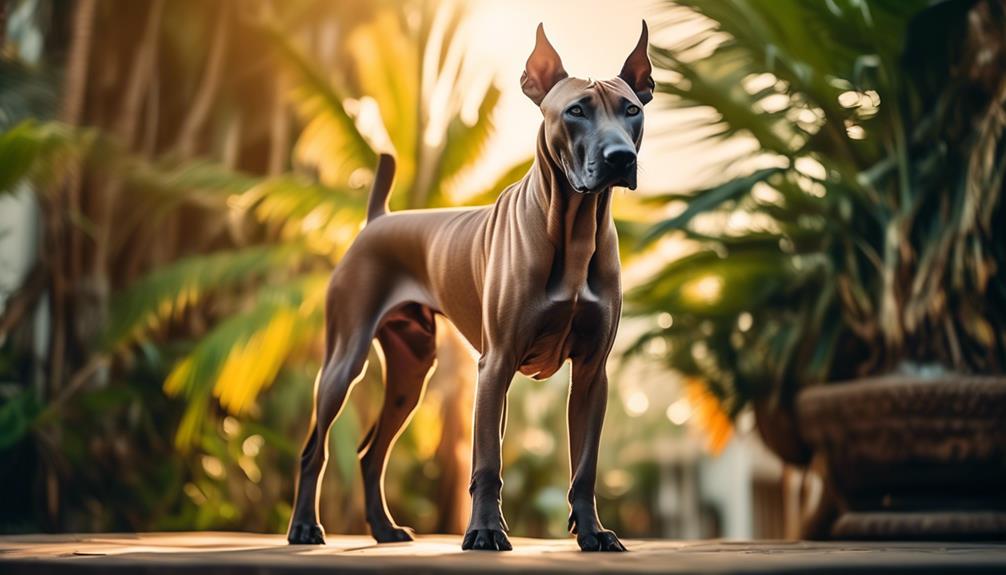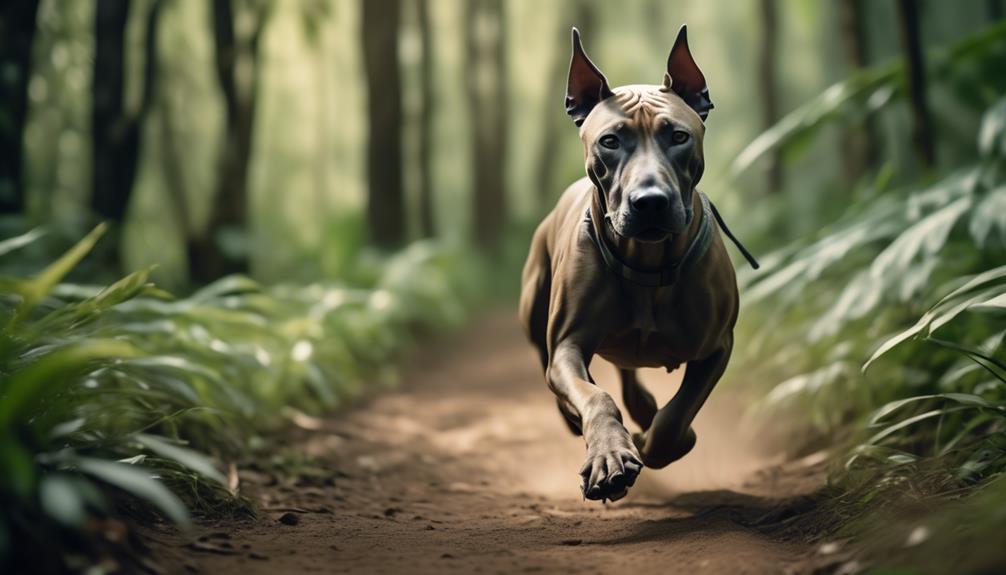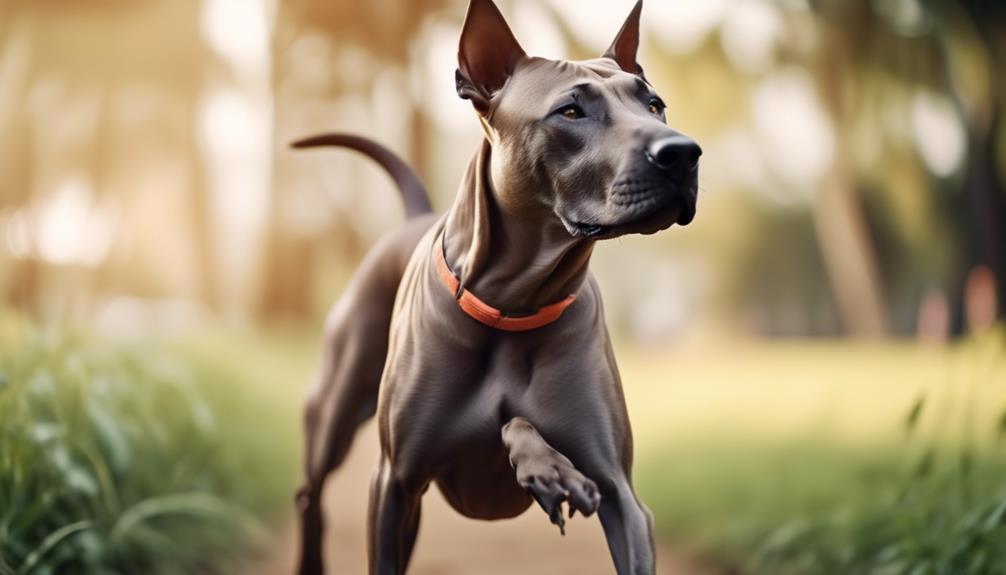
Are you curious about the fascinating world of Thai Ridgeback dogs? Well, hold onto your hats because we’re about to take you on an exhilarating journey into the world of this unique and captivating breed.
From their origins in Thailand to their distinctive coat colors and remarkable intelligence, Thai Ridgebacks are a breed like no other. But that’s just the tip of the iceberg!
In this article, we’ll delve into their temperament, exercise needs, health concerns, and much more. So, buckle up and get ready to discover everything you need to know about Thai Ridgeback dog breed information and characteristics.
You won’t want to miss a single detail!
Key Takeaways
- Thai Ridgebacks are independent, loyal, protective, and intelligent dogs.
- They have high exercise needs and require early and consistent training.
- Common health problems for Thai Ridgebacks include hip dysplasia, elbow dysplasia, and eye problems.
- Thai Ridgebacks can adapt well to apartment living, but factors such as size, energy levels, and behavior should be considered when choosing them for apartments.
Origin and Size
The Thai Ridgeback dog, originating from Thailand, is known for its unique characteristics and size. This breed is a medium-sized dog, with males standing at 22-24 inches tall at the shoulder and weighing between 45-65 pounds. Females are slightly smaller, measuring 20-22 inches tall at the shoulder and weighing 35-55 pounds.
The Thai Ridgeback is a hound breed, known for its independent, loyal, protective, and intelligent nature. They’ve a short, smooth coat that comes in various colors such as red, fawn, black, or brindle.
With a lifespan of 12-15 years, these dogs require early and consistent training, as well as high levels of exercise to keep them happy and healthy.
See another Dog breed profile.
Tibetan Mastiff Dog Breed
Temperament and Training

To ensure a well-behaved and balanced Thai Ridgeback, consistent training is essential. Training isn’t just about teaching basic commands; it’s about shaping their temperament and behavior. Here are four key factors to consider when training your Thai Ridgeback:
- Patience: Training a Thai Ridgeback requires patience as they can be independent and strong-willed. Stay calm and be persistent in your training efforts.
- Positive reinforcement: Use positive reinforcement techniques such as treats, praise, and play to motivate and reward your Thai Ridgeback for good behavior. This will create a positive association with training.
- Socialization: Expose your Thai Ridgeback to different environments, people, and other animals from a young age. This will help them develop good social skills and prevent aggression or fearfulness.
- Consistency: Be consistent with your training methods, rules, and boundaries. Thai Ridgebacks thrive on consistency, and it will help them understand what’s expected of them.
Exercise Needs and Health

After establishing a solid training foundation for your Thai Ridgeback, it’s important to address their exercise needs and overall health.
Thai Ridgebacks are high-energy dogs that require significant exercise and mental stimulation. Lack of exercise can lead to weight gain and unwanted behaviors like barking, chewing, and digging. Regular exercise is necessary to keep them physically and mentally healthy.
In addition to exercise, it’s crucial to prioritize their overall health. Thai Ridgebacks can be prone to specific medical conditions such as hip dysplasia and dermoid sinus. Regular veterinary checkups are important to detect health conditions early.
Maintaining their oral hygiene, including brushing their teeth, and providing a balanced diet based on their weight, energy, and health are also essential.
Adaptability for Apartment Living

When considering the adaptability of Thai Ridgeback dogs for apartment living, it’s important to take into account their size, energy levels, and behavior.
- Size: Thai Ridgebacks are medium-sized dogs, making them more suitable for apartments with limited space.
- Energy levels: While they’ve high exercise needs, Thai Ridgebacks can adapt to apartment living if their exercise requirements are met through regular walks and playtime.
- Behavior: Thai Ridgebacks are generally calm indoors and well-mannered, making them a good fit for apartment living. However, it’s crucial to provide them with mental stimulation and training to prevent boredom and unwanted behaviors.
Behavioral Characteristics and Exercise Needs

Thai Ridgebacks exhibit a range of behavioral characteristics and have varying exercise needs. These dogs have a tendency to bark or howl and may have a wanderlust streak. Some Thai Ridgebacks are high-energy and require significant exercise and mental stimulation. Training is necessary to teach them good manners and manage their high intensity levels.
Additionally, Thai Ridgebacks have varying levels of playfulness. It’s important to note that lack of exercise can lead to weight gain and unwanted behaviors such as barking, chewing, and digging. Therefore, when choosing a breed, it’s essential to consider their playfulness and exercise needs to ensure a harmonious living environment.
Regular exercise and mental stimulation are crucial for the well-being of Thai Ridgebacks.
Coat, Children, and Other Pets

To fully understand the Thai Ridgeback breed, it’s important to explore their coat, how they interact with children, and their compatibility with other pets.
- Their smooth and short coat isn’t only sleek but also easy to maintain, making them a low-maintenance breed.
- When it comes to children, Thai Ridgebacks can be great companions for older kids, as long as there’s proper interaction and supervision. However, it’s important to note that supervision is necessary when younger children and toddlers interact with these dogs.
- While Thai Ridgebacks generally get along well with other dogs, they may have a strong prey drive towards cats and small animals.
Frequently Asked Questions
Are Thai Ridgebacks Good With Children?
Yes, Thai Ridgebacks can be great companions for older children. However, supervision is necessary when younger children and toddlers interact with them. Always remember to supervise dogs and kids playing together, regardless of breed.
Do Thai Ridgebacks Have Any Specific Dietary Needs?
Thai Ridgebacks have specific dietary needs. Regular veterinary checkups are important to determine the appropriate feeding plan based on their weight, energy levels, and overall health. Proper nutrition is crucial for their well-being.
How Often Should Thai Ridgebacks Be Taken to the Veterinarian for Check-Ups?
You should take your Thai Ridgeback to the veterinarian for regular check-ups. It’s important to detect any potential health conditions early. Regular check-ups will help ensure your dog’s overall well-being and address any concerns promptly.
Can Thai Ridgebacks Live in Cold Climates?
Yes, Thai Ridgebacks can live in cold climates. They may require extra protection, such as warm clothing or shelter, to keep them comfortable in extreme cold temperatures.
Do Thai Ridgebacks Require a Lot of Grooming?
No, Thai Ridgebacks do not require a lot of grooming. Their short and smooth coat is easy to maintain. Regular brushing, occasional bathing, and nail trimming are usually sufficient to keep them looking their best.
Conclusion
In conclusion, if you’re looking for a loyal and intelligent companion, the Thai Ridgeback dog could be a great choice. With their independent nature and striking coat colors, they’re sure to turn heads wherever they go.
However, keep in mind their exercise needs and potential health issues. While they may not be the best fit for apartment living, with proper training and care, they can make a wonderful addition to an active and loving home.




